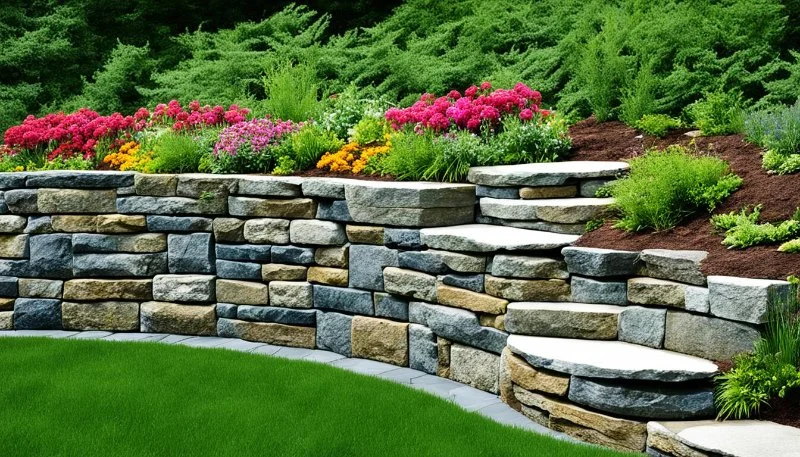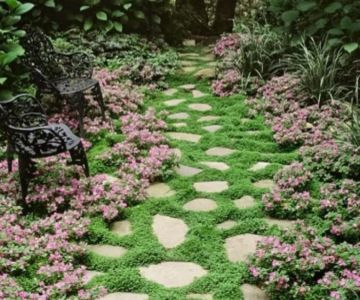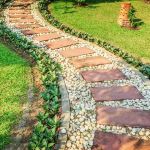
- Why Build a Stone Retaining Wall?
- Choosing the Right Materials for Your Stone Wall
- Step-by-Step Guide to Building a Stone Retaining Wall
- Common Challenges When Building a Stone Wall
- Real-Life Case Study: Building a Natural Stone Wall
Why Build a Stone Retaining Wall?
Building a stone retaining wall is an excellent way to enhance your landscape while serving a functional purpose. Whether you're looking to prevent soil erosion, create a terraced garden, or simply add visual interest to your yard, a stone retaining wall can offer both beauty and utility. Natural stone walls are particularly popular for their timeless, rustic look, which can blend seamlessly into most outdoor settings.
Additionally, stone walls are durable and low-maintenance, making them a great investment for your property. Unlike other materials like wood, stone doesn’t rot or require frequent upkeep. A well-built stone wall can last for decades, providing stability and aesthetic value to your landscape.
Choosing the Right Materials for Your Stone Wall
When planning to build a stone retaining wall, the choice of material is crucial for both functionality and aesthetics. Here are some popular stone options you can consider for your wall:

Tholens' Landscape & Garden Center
KankakeeKankakee CountyIllinois
31 Seedorf School Rd, Kankakee, IL 60901, USA
1. Fieldstone
Fieldstone is a popular choice for natural stone walls due to its irregular shapes and earthy colors. It’s often gathered from local quarries or even from your own land. Fieldstone creates a rustic, natural appearance that blends well with the landscape. However, it can be more difficult to work with due to its uneven shapes, requiring more time to find stones that fit properly.
2. Flagstone
Flagstone is a flat, smooth stone often used for patios and walkways, but it can also work well for retaining walls. Its large, flat surfaces make it easier to stack and fit together, creating a more uniform appearance. Flagstone comes in a variety of colors, from browns and reds to grays and purples, giving you many options to match your landscape style.
3. Limestone
Limestone is a versatile stone that is easy to work with and has a softer, more uniform texture. It often comes in pale hues of cream, yellow, and beige, which can give your retaining wall a clean, light look. Limestone is a good option if you want a more refined appearance but still want a natural stone feel.
4. Granite
Granite is a strong, dense stone with a unique, speckled appearance. It’s highly durable and resistant to weathering, making it ideal for retaining walls that need to stand up to harsh conditions. However, granite can be more expensive and harder to work with compared to other stones due to its toughness.
Step-by-Step Guide to Building a Stone Retaining Wall
Building a stone retaining wall requires patience, precision, and the right techniques to ensure the wall is both functional and aesthetically pleasing. Follow this step-by-step guide to build your own stone wall:
1. Plan and Design
Before you start, carefully plan the layout of your stone retaining wall. Measure the area where the wall will be built and decide on the height and width of the wall. If you’re working with a sloped area, consider how the wall will terrace the landscape. Make sure to check local building codes to see if a permit is required for your project.
2. Prepare the Site
Start by marking the outline of your wall using stakes and string. Then, dig a trench for the base of the wall, ensuring it’s deep enough to support the stones and allow for proper drainage. The trench should be about 6–8 inches deep and wide enough to accommodate the width of your stones. Make sure the trench is level to ensure the stability of the wall.
3. Lay the Foundation
For stability, it’s important to create a strong base. Begin by laying down a layer of crushed gravel or crushed stone to provide drainage and prevent the wall from shifting over time. Compact the gravel with a tamper to create a solid foundation. If needed, add more gravel until the trench is level and secure.
4. Build the Wall
Start stacking the stones at the back of the trench. Lay the first layer of stones tightly together, making sure each stone is level and stable. As you stack the stones, make sure to stagger the seams between layers to create a more stable and attractive structure. You may need to use smaller stones to fill gaps and ensure a tight fit. As you build, periodically check the level of the wall to ensure it’s even.
5. Add Drainage
Proper drainage is essential for the longevity of your stone wall. Add a perforated drainage pipe behind the wall to allow water to flow freely through the structure. This will help prevent pressure from building up behind the wall, which can cause it to fail. Fill the space behind the wall with gravel or crushed stone to facilitate drainage and prevent soil erosion.
6. Finish and Backfill
Once the wall is built, backfill the space behind it with soil and compact it. You can also add decorative stones or mulch to enhance the appearance of the wall. Finally, give your wall a thorough inspection, making sure it’s level, stable, and free from any gaps or misalignments.
Common Challenges When Building a Stone Wall
While building a stone retaining wall can be a rewarding project, it’s important to be prepared for potential challenges. Here are some common obstacles and how to handle them:
1. Uneven Stones
One of the biggest challenges when building a stone wall is dealing with uneven stones. To minimize this issue, take your time to sort through the stones and choose ones that fit together well. If you come across stones that are difficult to work with, consider using smaller filler stones to create a more even surface.
2. Drainage Issues
Improper drainage can cause a stone retaining wall to collapse over time. Make sure to properly install a drainage system behind the wall to redirect water and prevent soil buildup. If you're unsure how to do this, consult with a professional landscaper to ensure proper water management.
3. Stability Concerns
It’s essential to ensure that the wall is stable, especially if it’s being built on a slope. If you’re concerned about the stability of your wall, consider consulting with a structural engineer or using larger, heavier stones to create a more secure foundation.
Real-Life Case Study: Building a Natural Stone Wall
Take the example of the Johnson family, who wanted to create a natural stone retaining wall in their backyard to prevent soil erosion and add visual interest to their landscape. After researching different materials, they chose fieldstone for its natural appearance and earthy tones. With a bit of help from a local landscaper, they followed the steps outlined above, ensuring proper drainage and stability. The result was a stunning stone wall that not only served its functional purpose but also became a focal point in their garden.
This project highlights the importance of choosing the right materials, planning carefully, and taking your time to build a strong and aesthetically pleasing stone wall. With the right approach, you can create a natural stone retaining wall that enhances your outdoor space for years to come.








 Dunmyer Mowing LLC5.0 (3 reviews)
Dunmyer Mowing LLC5.0 (3 reviews) Dirty Deeds Lawn & Landscaping, LLC4.0 (65 reviews)
Dirty Deeds Lawn & Landscaping, LLC4.0 (65 reviews) Villwocks Outdoor Living4.0 (150 reviews)
Villwocks Outdoor Living4.0 (150 reviews) OROZCO LANDSCAPING LLC.5.0 (4 reviews)
OROZCO LANDSCAPING LLC.5.0 (4 reviews) Landscape Solutions FW4.0 (42 reviews)
Landscape Solutions FW4.0 (42 reviews) Land Design Landscaping4.0 (20 reviews)
Land Design Landscaping4.0 (20 reviews) How to Use Container Planting in Small Spaces for a Beautiful Garden
How to Use Container Planting in Small Spaces for a Beautiful Garden How to Landscape With Textured Leaves for Visual Interest
How to Landscape With Textured Leaves for Visual Interest How to Grow Ornamental Vines for Arbors and Trellises
How to Grow Ornamental Vines for Arbors and Trellises How to Install Low-Voltage Lighting in Your Garden: A Step-by-Step Guide
How to Install Low-Voltage Lighting in Your Garden: A Step-by-Step Guide How to Use Layers of Planting to Create Depth and Balance in Your Garden
How to Use Layers of Planting to Create Depth and Balance in Your Garden How to Build a Pathway That Blends With Nature: A Step-by-Step Guide
How to Build a Pathway That Blends With Nature: A Step-by-Step Guide